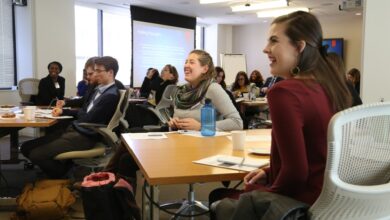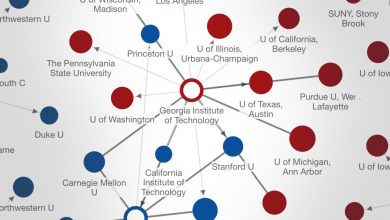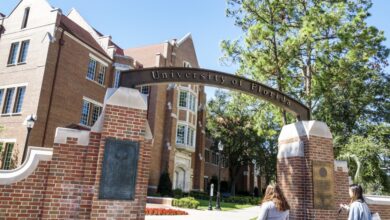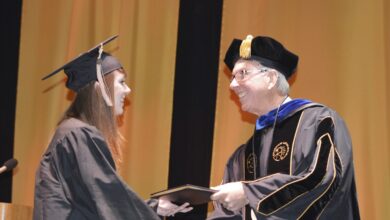The Academic Conference Will Never Be the Same

[ad_1]
But when she arrived at the Marriott Marquis Washington, D.C., a behemoth hotel in the nation’s capital, she found 100,000 square feet of mostly vacant meeting space.
“You think, ‘MLA,’ and you expect so many people, and it’s huge, and that’s where the big-name scholars are,” Mills said, sitting in the hotel lobby after the first day of the conference. “And it’s just odd to see it’s mostly empty.”
In the exhibit hall, exhibitors outnumbered the perusers. Some of the university press booths were stocked with books, but unstaffed, because their editors were attending virtually.
Two years after the pandemic forced academic groups out of hotels and conference centers, many are eager to return to in-person meetings. Conference fees provide associations with critical revenue. They offer university presses space to court potential authors and show off recent publications. And while online conferences may be easier to attend, many scholars long for the tradition of collaboration and conversation that can be difficult to replicate on a laptop screen.
The MLA had planned for the January conference to be mostly in person, with some online panels and attendance. But in late December, the association saw projected in-person attendance numbers plummet as the Omicron variant gripped the U.S. — a sign that the conference of the Before Times remained out of reach. In the end, with 68 sessions postponed till 2023 and a dozen canceled, nearly 83 percent of the 768 planned sessions were held virtually, an MLA official said.
Even prior to the pandemic, in-person conferences did not always deliver on their promise. They were expensive to attend, often inaccessible to people with physical disabilities, and they were criticized as clubby get-togethers for older, celebrity intellectuals.
When the pandemic arrived, Zoom appeared poised to be the great equalizer, allowing people to tune in from anywhere. And despite the shortcomings of virtual get-togethers, advocates say their affordability, convenience, small carbon footprint, and democratic nature make them worth keeping.
Like many mainstays of pre-pandemic life, the scholarly conference is in flux. After a two-year test of alternatives that are not only safer but address concerns about equity in higher education, this much is clear: There’s little chance of going back to the way things were.
The organizers gave him and other press editors readouts of all the visitors they received.
“It was very telling,” he says. “I think 95 percent who came to the booth were other exhibitors who were just trying to check out the other groups. We had almost no traffic from the actual people from the conference. It was somewhat dispiriting. Not unexpected.”
For Congdon, this was but one example of virtual conferences’ failure to deliver. The lack of a meeting lounge and travel schedule, he says, makes it feel as though there isn’t actually a conference occurring for the attendees, who can squeeze attending or giving a presentation into their normal day.
That makes it harder for press editors, like Congdon, to make connections with prospective authors — one of the main reasons they go to conferences.
Faculty members, too, complain that connections — social ones and scholarly ones — are weak at virtual conferences. Beyond the technical glitches and annoyances (“You’re on mute, Rachel!”), the virtual conference, many say, cannot replicate an in-person meeting.
Lauren Rule Maxwell, an English professor at the Citadel, decided to attend the MLA in person this year. She says it was important for her to be physically present to meet rising stars in her field. Years ago, she attended as a junior faculty member to present a paper on Margaret Atwood, and a member of the Atwood Society approached her afterward and invited her to attend its next business meeting. Now she’s president of the society.

Mark Harris for The Chronicle; photos from Getty and iStock
“I became part of that intellectual community because I was there in person, and I decided to go,” she said during a chat between sessions. “It’s so important to be able to form that type of connection.”
That’s much harder over Zoom, she said.
Barbara Fuchs agrees. “If you hear someone who is newer to the profession give an amazing paper, or someone just asks you a really interesting question and you want to follow up, it’s much simpler to do that in person,” says Fuchs, a professor of Spanish and English at the University of California at Los Angeles whose term as president of the MLA just ended. “It’s complicated to do that on email and have the same quality of exchange.”
Spontaneous exchanges are also less likely to happen. Michael L. Boucher Jr., an associate professor of curriculum and instruction at Texas A&M University at San Antonio, misses stumbling upon conversations that give him ideas he might use in his work. He also misses talking with old friends and colleagues from graduate school. It’s rare to run into someone in a Zoom room.
In-person conferences can also be critical to the financial health of associations. The American Anthropological Association lost roughly $1.3 million when the 2020 conference went online, said Ed Liebow, executive director. In normal times, the conference pulls in roughly 25 percent of the group’s annual operating revenue through registration fees, sponsorships, and exhibition fees. The percentage varies among associations, though. Paula M. Krebs, executive director of the MLA, said that conference fees make up less than 5 percent of the MLA’s annual gross operating revenue.
Despite the disadvantages of virtual meetings, their rise during the pandemic provides benefits that many scholars are not ready to give up.
The Association of Schools and Programs of Public Health planned to offer two options for its 2022 convention this coming March — in person and online — but after an “intense” planning meeting in early January, the group decided to hold that conference completely online as well.
Not only will that be safer, says Laura Magaña, the association’s president and chief executive, but it will accommodate busy schedules in the event of another hard wave of the pandemic. “People have other issues, as well, in terms of family, schooling,” Magaña says. “Everything that we’re seeing for the work environment, it’s something for the conferences.”
“So we said, for safety, for equity and for visibility, let’s do it online.” Roughly a thousand people would typically come to the D.C. area for the annual meeting, she said. When it went remote in 2020, it reached about 3,500 people.
“I’ve had a great chance to attend a lot of panels I probably otherwise wouldn’t have been able to attend and to actually hear these scholars speak in real time,” Martschenko said.
As Zoom and other platforms continue to make improvements to ease collaboration and socializing, a better virtual conference experience may be near — if associations are willing to put in the effort to improve it.
Martschenko said the groups should think more creatively about the virtual conference — “not as the consolation prize, because they can’t go in-person, but as its own system with its own benefits.”
A better virtual conference experience may be near — if associations are willing to put in the effort to improve it.
For starters, virtual conferences could help mitigate the effects of climate change. A study published in Nature Communications in December found that transitioning from in-person to virtual conferencing could reduce carbon footprint by 94 percent and energy use by 90 percent. The study also found that using hubs across the country to host hybrid conferences with more than half of participation in-person could slash carbon footprint and energy use by two-thirds.
Virtual meetings also eliminate a lot of the physical barriers that can make it hard for disabled academics to attend in-person conferences — lack of wheelchair-accessible venues and transportation, poor accommodations for deaf or hard-of-hearing people, over-stimulating environments.
That’s not to say virtual conferences don’t introduce access issues of their own. Associations often use virtual platforms that aren’t accessible to people who use screen readers or those with cognitive difficulties, says Krystal Vasquez, a Ph.D. candidate in atmospheric chemistry at the California Institute of Technology, who published an essay in Scientific American titled “Virtual Conferences Aren’t as Accessible as You Might Think.” And while more associations are recording conference sessions for attendees to use later, she says, they often don’t fix the error-riddled automated captions that accompany the videos, making attendance difficult for deaf and hard-of-hearing participants.
“The one thing that all conferences should do is make sure that they’re actually asking disabled researchers, disabled academics what they need, because disability can vary really widely,” Vasquez says.
A lot of conferences blame their inaccessibility on limited funding, she says. But “I stand by the idea that if you don’t have funds to make a conference accessible, then you don’t have funds to run a conference. That should be built into the budget from the beginning.”
The MLA did so: Next to the registration booth was an accessibility booth where attendees could receive assistance from staff members. Organizers set aside a sober room, a quiet room, and a lactation room. Sign-language interpretation and real-time captioning were available upon request, and online convention sessions were automatically captioned or transcribed. Registered MLA members could also request reimbursement of up to $400 for child care, and all participants who required accessible transportation could be reimbursed up to $150.
Accessibility can also be a matter of finances. Some associations offer virtual-conference tickets at a lower rate than in-person ones, and even if they don’t, attending remotely eliminates travel and lodging expenses.
“Many graduate students and adjunct faculty are simply not able to go to a conference,” says the University Press of Kansas’ Congdon. “They don’t have the resources or their institutional support to make that happen.”
If you don’t have funds to make a conference accessible, then you don’t have funds to run a conference.
During the pandemic, several associations have introduced or expanded programs to defray the costs of in-person or virtual participation. The American Anthropological Association started a “Hardship Registration Waiver Program” last fall through which annual meeting registrants could contribute to a fund to help their fellow AAA members pay registration expenses; it also created the opportunity for sponsors to pay for others’ meeting registrations. And the American Political Science Association expanded its assistance program last year to provide both in-person travel grants and virtual accessibility grants, intended to reduce the costs of participation. The MLA has long offered grants to non-tenure-track faculty members, unemployed MLA members, and graduate students for travel.
These programs — combined with widespread availability of virtual conferencing — can help democratize academe by removing the barriers to entry that have long shut low-paid and disabled academics out of the meetings. But in order for these efforts to make long-term improvements to equity, they must extend beyond the pandemic.
And academics say that if conferences are to be truly equitable, that material support must be accompanied by efforts to change the cultural elitism on display.
Lauren Garcia, a sociology Ph.D. student at the University of Virginia, takes issue with the “performance” of the academic meeting — an obsession with institutions, titles, and connections — that she has seen play out when scholars gather in person.
Garcia, who earned her masters under the tutelage of Tressie McMillan Cottom, a MacArthur fellow who now teaches at the University of North Carolina at Chapel Hill, says she noticed people responded to her differently when she mentioned McMillan Cottom was her adviser at conference sign-in tables.
“If you are not in an elite institution or didn’t make contact with the right connections, you don’t know how to even act,” she says. “There’s all these articles about what you’re supposed to do as a participant in an academic conference, which is crazy to me, because the point is, the organizers are supposed to facilitate a space that’s open for everyone to participate.”
So Garcia and McMillan Cottom, for whom she now serves as senior project manager, have started holding alternatives called “unconferences” — events they described in a Chronicle essay as “(1) participant-oriented, (2) informal, and (3) democratic.”
The first event, which was live, was free to attend, thanks to a significant subsidy from the university. The second was virtual. Garcia says she hopes associations continue to provide virtual attendance as an option as they return to in-person meetings.
“Nothing has been better for me, personally, than remote options to everything — as a disabled person, as a person who really prioritizes inclusion,” Garcia says. “Having an online component is necessary at this point because we’ve shown how it really opens up participation.”
Hybrid conferences have been praised for many of the same environmental and accessibility-related reasons as virtual conferences. Additionally, most hybrid conferences allow guests to attend some sessions online and some in-person, allowing for further flexibility; the MLA convention set aside a “viewing room” for attendees participating in person to attend virtual sessions. Several academic groups are slated to host their spring meetings through a hybrid format this year, including the American Chemical Society and the Human Biology Association.
But hybrid conferences present their own problems. Several associations’ executive directors told The Chronicle they were more expensive than either of the other options and required more labor.
“If you’re doing a hybrid meeting, you have to have the expense of a virtual platform,” says Steven R. Smith, executive director of the American Political Science Association. “You then have to have enhanced Wi-Fi. There’s a lot of expenses that go with putting on a virtual meeting, and then you have much lower revenues because you don’t have the [same] in-person attendance.” Some hotels and conference centers are not sufficiently equipped to support streaming and Zoom.
Scholars will have to think creatively to get the most out of hybrid conferences. Matthew Cheney, assistant professor and director of interdisciplinary studies at Plymouth State University, in New Hampshire, participated in the MLA remotely, including on a virtual panel on Virginia Woolf and, afterward, continued the conversation at a virtual Woolf Society reception.
“We’re adjusting because that’s the responsible thing to do,” Cheney said in an interview before the conference.
Scholarly groups, too, are thinking about how online technologies could augment the conference experience instead of being seen as just lackluster replacements.
“All of the associations have learned how much we can do virtually for our members and that we don’t have to confine it to the four days of the in-person convention,” says Krebs, the MLA executive. “We can do professional development, webinars, gatherings all year round when we do them virtually. And so we’re looking at how to expand the value that people get from the convention — beyond the four days of the convention.”
Garcia, the Ph.D. student at UVa, says she doesn’t think in-person conferences will soon fade into oblivion. But she has noticed a generational divide: Younger people generally prefer making online communities, and older people generally prefer finding community in person.
In the long run, the degree to which attendees can customize their experience will be a bellwether of academe’s commitment to equity and inclusion.
If the possibility of online options fades with time, associations may find themselves characterized the way they hate most: as elite, homogenous clubs that are out of touch.
[ad_2]
Source link







